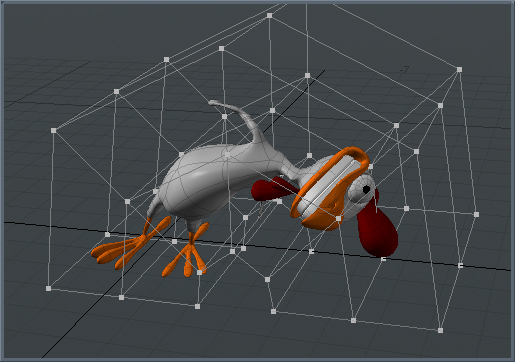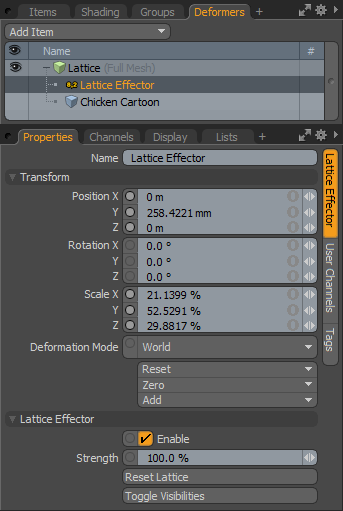
Effectors are a means to affect a target item, generally a Mesh layer, deforming it in specific ways. The 'Lattice Effector' when assigned, creates a structured array of points across the Mesh like a cage. Each individual vertex of this cage can be moved, deforming the underlying mesh, smoothly interpolating the Deformation between the vertex locations. Users can then animate these cage handles, producing very interesting deformation effects, such as the elephant squeezing through the keyhole gag.
Applying an Effector
While simply adding an Effectors using the Items Lists 'Add Items' option is possible, it won't produce the intended result; only placing the Effector in the Items list. For proper results the Effector must be connected to the Mesh layer by way of a 'General Influence'. The General Influence acts upon the mesh, while the Effector itself produces the instructions on how the Influence should modify its target.
Properly applying the Lattice Effector to a Mesh is easy, in the 'Setup' workspace layout, under the 'Deformers' toolbox subtab, LMB+click the 'Lattice' deformer assign button, opening the 'Create Lattice Deformer' dialog-

In this dialog the user defines the number of lattice handles along each axis. Also, make sure the 'Auto Fitting' option is enabled, this will fit the cage to the bounding box volume of the target mesh automatically. In the 'Parent to' menu, select the target mesh for deforming (or select the target item prior to opening the dialog to auto-populate this option). Once everything is assigned properly, LMB+click OK to actually generate the Lattice.
When assigned as such, a wireframe cage appears around the Mesh Item layer in the number of divisions specified, at each division there is a handle (a Locator actually). These handles can then be selected in 'Items' mode and positioned with the standard Transform tools, deforming the underlying mesh item. The handles can be modified individually, or selected in groups and moved in together. Users can also select the 'Lattice Effector' item itself (in the 'Groups' or 'Deformers' viewports) and adjust its attributes found in the 'Properties' viewport. Here there are also options for users to 'Reset' the Lattice as well as update the number of divisions.
 Name: This data field displays the current item name. Users may easily change it by LMB-clicking within the field and typing the new name.
Name: This data field displays the current item name. Users may easily change it by LMB-clicking within the field and typing the new name.
Transform--
Position: An Item transform that allows the user to numerically position the Effector item in XYZ space. The Effector cage's position relative to the geometry will have a dramatic effect on how it Deforms the target. It should usually be placed centered on the target bounding box volume (Note that moving the cage is not the same thing as moving all the handles of the cage).
Rotation: An Item transform that allows the user to numerically set the rotation of the Effector item. The Effector cage's rotation relative to the geometry will have a dramatic effect on how it Deforms the target. (Note that rotating the cage is not the same thing as moving all the handles of the cage).
Scale: An Item transform that allows the user to numerically set the size of the item representation in the 3D viewport. The Effector cage's size relative to the geometry will have a dramatic effect on how it Deforms the target. (Note that scaling the cage is not the same thing as moving all the handles of the cage).
Deformation Mode: The 'Deformation Mode' determines how the transforms of the Effector translate into a deformation-
World- This is the default setting and determines the deformation based on the world position of the effector. In most cases, this provides the expected results.
Local- This setting applies the deformation relative to the Setup position of the item as if the item were still at the rest pose regardless of the position of the Effector. Useful for the order of operation workflow when rigging.
Local ** Rotation Modes- Identical to the 'Local' mode but only the specified rotation is applied applying a deformation that is more like a Rotation Effector with Parametric interpolation.
Reset: Resets the selected transform values to (0,0,0) returning the item back to their default state.
Zero: Resets the chosen transform property values to '0', leaving the items position intact. This is done by adding a negative transform item to the items transform channels.
Add: Transform Items are the channel groups associated to an item that store its transform values, controlling its position, rotation and/or scale. By default, new items do not have any transform items associated with them (even though they are visible here within the Properties panel). This is useful as an optimization as only the necessary transforms are added on an as-needed basis, reducing scene overhead. There are several ways to add them. One is by simply transforming the target item with one of the various transform tools (or by editing the values input fields). This action will cause the particular transform item to be added automatically to the 'Channels' viewport list. The 'Add' function here can also be used to add the selected set of transforms to the Channel list while keeping the default 0,0,0 values (a necessary step for 'Referencing', in order to override the channels, they must first exist).
Lattice Effector--
Enable: Toggles the effect of the layer on or off. When unchecked (disabled), the layer has no influence on the scene. However, disabled layers are still saved with the scene and its values are persistent across MODO sessions.
Strength: Determines the amount influence the Effector has on the target mesh, allowing users to transform between a deformed version and an undeformed version.
Reset Lattice: This button opens the 'Reset Lattice Deformer' dialog allowing users to re-define the number of Controls handles-

Division X/Y/Z: These option define the number of control handles given to the Effector. Adjusting the number of divisions after the fact without resetting the Control positions may produce undesirable results.
Auto Fitting: This option, when enabled, will scale the size of the control cage to the bounding box size of the target mesh. When disabled the resulting cage will be a default 1 meter square.
Reset Lattice Transform: This option will reset any transform values applied to the Lattice Effector itself.
Reset Control Positions: This option will remove any transforms applied to the Control handles, returning the Effector to its initial base shape.
Toggle Visibilities: This option toggles the visibility (and therefore the selectability) of the control handles in the 3D viewport.


